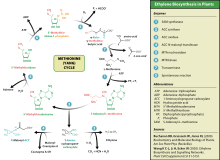Methionine
 Skeletal formula of the canonical form of methionine
| |||
| |||
| Names | |||
|---|---|---|---|
| IUPAC name
Methionine
| |||
| Other names
2-amino-4-(methylthio)butanoic acid
| |||
| Identifiers | |||
3D model (
JSmol ) |
|||
| Abbreviations | Met, M | ||
| ChEBI |
| ||
| ChEMBL |
| ||
| ChemSpider | |||
| DrugBank |
| ||
ECHA InfoCard
|
100.000.393 | ||
| EC Number |
| ||
| KEGG |
| ||
PubChem CID
|
|||
| UNII |
| ||
CompTox Dashboard (EPA)
|
|||
| |||
| |||
| Properties[2] | |||
| C5H11NO2S | |||
| Molar mass | 149.21 g·mol−1 | ||
| Appearance | White crystalline powder | ||
| Density | 1.340 g/cm3 | ||
| Melting point | 281 °C (538 °F; 554 K) decomposes | ||
| Soluble | |||
| Acidity (pKa) | 2.28 (carboxyl), 9.21 (amino)[1] | ||
| Pharmacology | |||
| V03AB26 (WHO) QA05BA90 (WHO), QG04BA90 (WHO) | |||
| Supplementary data page | |||
| Methionine (data page) | |||
Except where otherwise noted, data are given for materials in their standard state (at 25 °C [77 °F], 100 kPa).
| |||
Methionine (symbol Met or M)[3] (/mɪˈθaɪəniːn/)[4] is an essential amino acid in humans.
As the precursor of other non-essential amino acids such as
Methionine was first isolated in 1921 by
Biochemical details
Methionine (abbreviated as Met or M; encoded by the codon AUG) is an α-
amino acid.In nuclear genes of
A proteinogenic amino acid
Cysteine and methionine are the two sulfur-containing proteinogenic amino acids. Excluding the few exceptions where methionine may act as a redox sensor (e.g.,methionine sulfoxide[8]), methionine residues do not have a catalytic role.[9] This is in contrast to cysteine residues, where the thiol group has a catalytic role in many proteins.[9] The thioether within methionine does however have a minor structural role due to the stability effect of S/π interactions between the side chain sulfur atom and aromatic amino acids in one-third of all known protein structures.[9] This lack of a strong role is reflected in experiments where little effect is seen in proteins where methionine is replaced by norleucine, a straight hydrocarbon sidechain amino acid which lacks the thioether.[10] It has been conjectured that norleucine was present in early versions of the genetic code, but methionine intruded into the final version of the genetic code due to the fact it is used in the cofactor
Encoding
Methionine is one of only two amino acids encoded by a single
The methionine codon AUG is also the most common start codon. A "Start" codon is message for a ribosome that signals the initiation of protein translation from mRNA when the AUG codon is in a Kozak consensus sequence. As a consequence, methionine is often incorporated into the N-terminal position of proteins in eukaryotes and archaea during translation, although it can be removed by post-translational modification. In bacteria, the derivative N-formylmethionine is used as the initial amino acid.
Derivatives
S-Adenosylmethionine

The methionine-derivative
Biosynthesis

As an essential amino acid, methionine is not synthesized
- First, aspartic acid is converted via β-aspartyl semialdehyde into homoserine by two reduction steps of the terminal carboxyl group (homoserine has therefore a γ-hydroxyl, hence the homo- series). The intermediate aspartate semialdehyde is the branching point with the lysine biosynthetic pathway, where it is instead condensed with pyruvate. Homoserine is the branching point with the threonine pathway, where instead it is isomerised after activating the terminal hydroxyl with phosphate (also used for methionine biosynthesis in plants).[9]
- Homoserine is then activated with a phosphate, succinyl or an acetyl group on the hydroxyl.
- In plants and possibly in some bacteria,[9] phosphate is used. This step is shared with threonine biosynthesis.[9]
- In most organisms, an acetyl group is used to activate the homoserine. This can be catalysed in bacteria by an enzyme encoded by metX or metA (not homologues).[9]
- In enterobacteria and a limited number of other organisms, succinate is used. The enzyme that catalyses the reaction is MetA and the specificity for acetyl-CoA and succinyl-CoA is dictated by a single residue.[9] The physiological basis for the preference of acetyl-CoA or succinyl-CoA is unknown, but such alternative routes are present in some other pathways (e.g. lysine biosynthesis and arginine biosynthesis).
- The hydroxyl activating group is then replaced with cysteine, methanethiol, or hydrogen sulfide. A replacement reaction is technically a γ-Michael addition. All the enzymes involved are homologues and members of the Cys/Met metabolism PLP-dependent enzyme family, which is a subset of the PLP-dependent fold type I clade. They utilise the cofactor PLP (pyridoxal phosphate), which functions by stabilising carbanion intermediates.[9]
- If it reacts with cysteine, it produces cystathionine-β-lyase (metC). Cystathionine is bound differently in the two enzymes allowing β or γ reactions to occur.[9]
- If it reacts with free hydrogen sulfide, it produces homocysteine. This is catalysed by O-acetylhomoserine aminocarboxypropyltransferase (formerly known as O-acetylhomoserine (thiol)-lyase. It is encoded by either metY or metZ in bacteria.[9]
- If it reacts with methanethiol, it produces methionine directly. Methanethiol is a byproduct of catabolic pathway of certain compounds, therefore this route is more uncommon.[9]
- If it reacts with cysteine, it produces
- If homocysteine is produced, the thiol group is methylated, yielding methionine. Two cobalamin (vitamin B12) dependent and one is independent.[9]
The pathway using cysteine is called the "transsulfuration pathway", while the pathway using hydrogen sulfide (or methanethiol) is called "direct-sulfurylation pathway".
Cysteine is similarly produced, namely it can be made from an activated serine and either from homocysteine ("reverse transsulfurylation route") or from hydrogen sulfide ("direct sulfurylation route"); the activated serine is generally O-acetylserine (via CysK or CysM in E. coli), but in Aeropyrum pernix and some other archaea O-phosphoserine is used.[15] CysK and CysM are homologues, but belong to the PLP fold type III clade.
Transsulfurylation pathway
Enzymes involved in the E. coli transsulfurylation route of methionine biosynthesis:
- Aspartokinase
- Aspartate-semialdehyde dehydrogenase
- Homoserine dehydrogenase
- Homoserine O-transsuccinylase
- Cystathionine-γ-synthase
- Cystathionine-β-lyase
- homocysteine methyltransferase or betaine—homocysteine S-methyltransferase.)
Other biochemical pathways

Although mammals cannot synthesize methionine, they can still use it in a variety of biochemical pathways:
Catabolism
Methionine is converted to
SAM-e serves as a methyl donor in many (2)
(3) Adenosylhomocysteinase cysteine.
Regeneration
Methionine can be regenerated from homocysteine via (4) methionine synthase in a reaction that requires vitamin B12 as a cofactor.
Homocysteine can also be remethylated using
Reverse-transulfurylation pathway: conversion to cysteine
Homocysteine can be converted to cysteine.
- (5) cystathionine-γ-lyase.
- (7) The enzyme α-ketoacid dehydrogenase converts α-ketobutyrate to propionyl-CoA, which is metabolized to succinyl-CoA in a three-step process (see propionyl-CoA for pathway).
Ethylene synthesis
This amino acid is also used by plants for synthesis of ethylene. The process is known as the Yang cycle or the methionine cycle.

Metabolic diseases
The degradation of methionine is impaired in the following metabolic diseases:
- Combined malonic and methylmalonic aciduria (CMAMMA)
- Homocystinuria
- Methylmalonic acidemia
- Propionic acidemia
Chemical synthesis
The industrial synthesis combines
Human nutrition
Methionine supplementation benefit those suffering from copper poisoning.[18]
Overconsumption of methionine, the methyl group donor in DNA methylation, is related to cancer growth in a number of studies.[19][20]
Requirements
The Food and Nutrition Board of the U.S. Institute of Medicine set Recommended Dietary Allowances (RDAs) for essential amino acids in 2002. For methionine combined with cysteine, for adults 19 years and older, 19 mg/kg body weight/day.[21]
This translates to about 1.33 grams per day for a 70 kilogram individual.
Dietary sources
| Food | g/100 g |
|---|---|
Egg , white, dried, powder, glucose reduced |
3.204 |
Sesame seeds flour (low fat) |
1.656 |
| Brazil nuts | 1.124 |
| Cheese, Parmesan, shredded | 1.114 |
hemp seed , hulled |
0.933 |
| Soy protein concentrate | 0.814 |
Chicken , broilers or fryers, roasted |
0.801 |
Fish , tuna, light, canned in water, drained solids |
0.755 |
| Beef, cured, dried | 0.749 |
| Bacon | 0.593 |
| chia seeds | 0.588 |
| Beef, ground, 95% lean meat / 5% fat, raw | 0.565 |
| Pork, ground, 96% lean / 4% fat, raw | 0.564 |
| Soybeans | 0.547 |
Wheat germ |
0.456 |
| Egg, whole, cooked, hard-boiled | 0.392 |
| Oat | 0.312 |
| Peanuts | 0.309 |
| Chickpea | 0.253 |
| Corn, yellow | 0.197 |
| Almonds | 0.151 |
| Beans, pinto, cooked | 0.117 |
| Lentils, cooked | 0.077 |
| Rice, brown, medium-grain, cooked | 0.052 |
High levels of methionine can be found in eggs, meat, and fish; sesame seeds, Brazil nuts, and some other plant seeds; and cereal grains. Most fruits and vegetables contain very little. Most legumes, though protein dense, are low in methionine. Proteins without adequate methionine are not considered to be complete proteins.[22] For that reason, racemic methionine is sometimes added as an ingredient to pet foods.[23]
Health
Loss of methionine has been linked to senile greying of hair. Its lack leads to a buildup of hydrogen peroxide in hair follicles, a reduction in tyrosinase effectiveness, and a gradual loss of hair color.[24] Methionine raises the intracellular concentration of glutathione, thereby promoting antioxidant-mediated cell defense and redox regulation. It also protects cells against dopamine induced nigral cell loss by binding oxidative metabolites.[25]
Methionine is an intermediate in the biosynthesis of cysteine, carnitine, taurine, lecithin, phosphatidylcholine, and other phospholipids. Improper conversion of methionine can lead to atherosclerosis[26] due to accumulation of homocysteine.
Other uses
DL-Methionine is sometimes given as a supplement to dogs; It helps reduce the chances of kidney stones in dogs. Methionine is also known to increase the urinary excretion of quinidine by acidifying the urine. Aminoglycoside antibiotics used to treat urinary tract infections work best in alkaline conditions, and urinary acidification from using methionine can reduce its effectiveness. If a dog is on a diet that acidifies the urine, methionine should not be used.[27]
Methionine is allowed as a supplement to organic poultry feed under the US certified organic program.[28]
Methionine can be used as a nontoxic pesticide option against giant swallowtail caterpillars, which are a serious pest to orange crops.[29]
See also
- Allantoin
- Formylmethionine
- Methionine oxidation
- Paracetamol poisoning
- Photoreactive methionine
- S-Methylcysteine
References
- ^ Dawson RM, Elliott DC, Elliott WH, Jones KM (1959). Data for Biochemical Research. Oxford: Clarendon Press.
- ISBN 0-8493-0462-8..
- ^ "Nomenclature and Symbolism for Amino Acids and Peptides". IUPAC-IUB Joint Commission on Biochemical Nomenclature. 1983. Archived from the original on 9 October 2008. Retrieved 5 March 2018.
- ^ "Methionine". Oxford University Press. Archived from the original on January 27, 2018.
- ^ Pappenheimer AM (1987). "A Biographical Memoir of John Howard Mueller" (PDF). Washington D.C.: National Academy of Sciences.
- ISSN 1881-1272.
- PMID 22369087.
- PMID 15680220.
- ^ PMID 24939187.
- S2CID 11380413.
- S2CID 17224537.
- PMID 4731949.
- PMID 20139989.
- S2CID 4371485.
- S2CID 28360765.
- ISBN 978-3527306732.
- ^ Barger G, Weichselbaum TE (1934). "dl-Methionine". Organic Syntheses. 14: 58; Collected Volumes, vol. 2, p. 384.
- ^ "Methionine". WebMD.
- PMID 22342103.
- PMID 14585259.
- ISBN 978-0-309-08525-0.
- S2CID 32264340.
- ISBN 978-0-87605-467-3.
- S2CID 16069417.
- PMID 19093882.
- PMID 9509248.
- ^ Grimshaw, Jane (July 25, 2011) Methionine for Dogs uses and Side Effects. critters360.com
- ^ "Rules and Regulations". Federal Register. 76 (49): 13501–13504. March 14, 2011.
- S2CID 45255198.
External links
- Rudra MN, Chowdhury LM (30 September 1950). "Methionine Content of Cereals and Legumes". S2CID 3026278.



